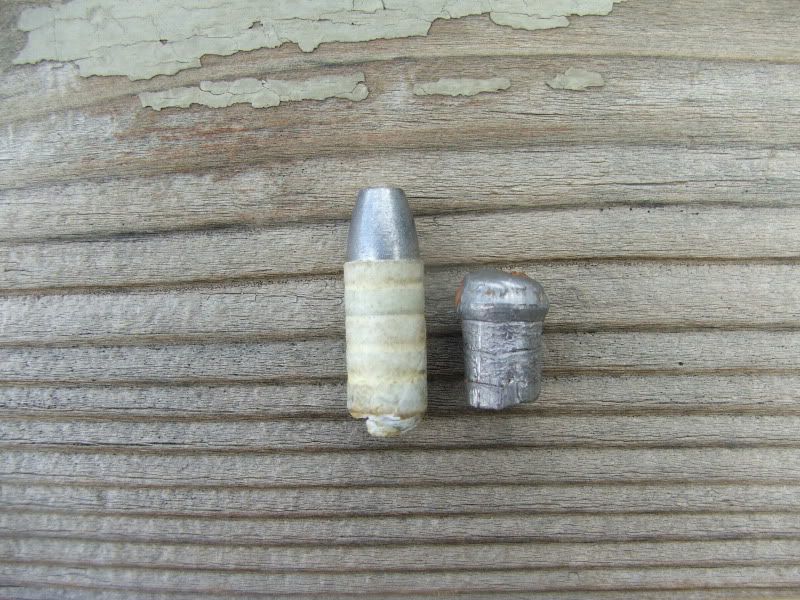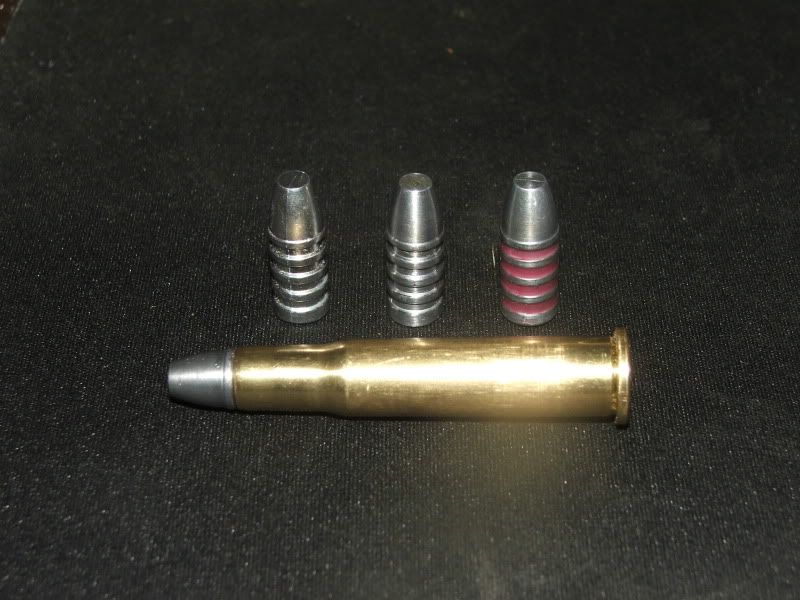Rangefinder
New member
So I've been playing with PP'ing for my .32 Winchester for a while now and am really impressed with what has turned out with it. Accuracy is fantastic--it's well within minute-of-heart-shot on a deer at 100 yds, so it's back to being a superb brush gun that it was originally intended to be.
I was curious what kind of penetration I was getting with the alloy and velocities I was running on it. I don't have a chrony anymore since a buddy sent mine to chrony-heaven some time ago and never bothered replacing it. BUT... this is a .321 lyman 155gr. flat nose squeezed down to .311 then patched back up with 2 wraps of notebook paper and loaded over 29.5gr. H335 for the bottom end of a full jacketed load and a listed velocity just under 2100FPS. The target/catch was 1" dry phone book, 1-gallon water jug, a second 1-gallon water jug, a 5-gallon water jug (square, so a full 12" front to back), 2" dry phone book, and finally a big log (my chopping block--ponderosa pine).
I expected the phone book to be a minor issue.
I expected the first jug to get ripped apart.
I expected the second jug to be in a serious state of disarray.
What I DIDN'T expect was the 5-gallon jug to be split nearly completely in half vertically, nor did I expect full penetration of the back phone book and to have to dig the boolit out of the pine log with 1 1/2 inches of penetration!

Patched weight is 157gr. Final weight after digging it out of the log was 110.5gr and portions of the nose were in the bottom of what was left of the 5-gallon jug which brought the total recovered weight up to 139.4gr.
The result? I'd use this on any deer in the country and not feel totally under-powered if I had to use it on an elk with a broadside shot.
I'm impressed!
I was curious what kind of penetration I was getting with the alloy and velocities I was running on it. I don't have a chrony anymore since a buddy sent mine to chrony-heaven some time ago and never bothered replacing it. BUT... this is a .321 lyman 155gr. flat nose squeezed down to .311 then patched back up with 2 wraps of notebook paper and loaded over 29.5gr. H335 for the bottom end of a full jacketed load and a listed velocity just under 2100FPS. The target/catch was 1" dry phone book, 1-gallon water jug, a second 1-gallon water jug, a 5-gallon water jug (square, so a full 12" front to back), 2" dry phone book, and finally a big log (my chopping block--ponderosa pine).
I expected the phone book to be a minor issue.
I expected the first jug to get ripped apart.
I expected the second jug to be in a serious state of disarray.
What I DIDN'T expect was the 5-gallon jug to be split nearly completely in half vertically, nor did I expect full penetration of the back phone book and to have to dig the boolit out of the pine log with 1 1/2 inches of penetration!

Patched weight is 157gr. Final weight after digging it out of the log was 110.5gr and portions of the nose were in the bottom of what was left of the 5-gallon jug which brought the total recovered weight up to 139.4gr.
The result? I'd use this on any deer in the country and not feel totally under-powered if I had to use it on an elk with a broadside shot.
I'm impressed!

